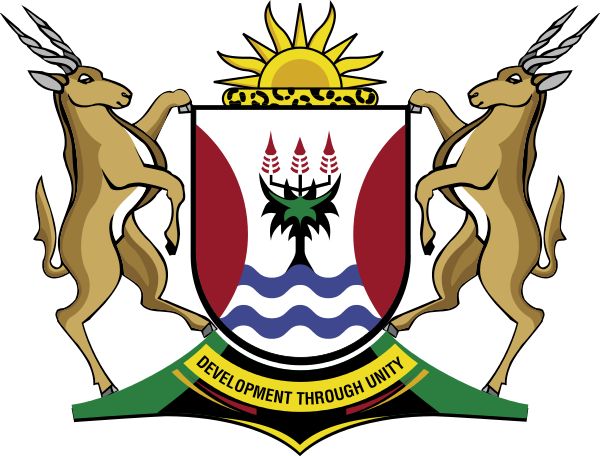
Eastern Cape Province
Coat of Arms
|
Arms of the Eastern Cape
The Eastern Cape province is located in south-east central South Africa. It was established on 27 April 1994 and includes the southeastern part of the former Cape Province and the former homelands of Ciskei and Transkei. Its capital is Bhiso (formerly capital of the Ciskei).
The provincial arms were registered with the South African Bureau of Heraldry on 25 March 1996 and are described as follows:
- ARMS: Argent, between flanches Gules, in base bars gemelles wavy Azure and in chief a tree-aloe issuant Vert, with three racemes Gules; the shield ensigned of a leopard-skin head ring proper with a demi-sun issuant Or.
- SUPPORTERS: Two eland proper.
- MOTTO: "DEVELOPMENT THROUGH UNITY".
|
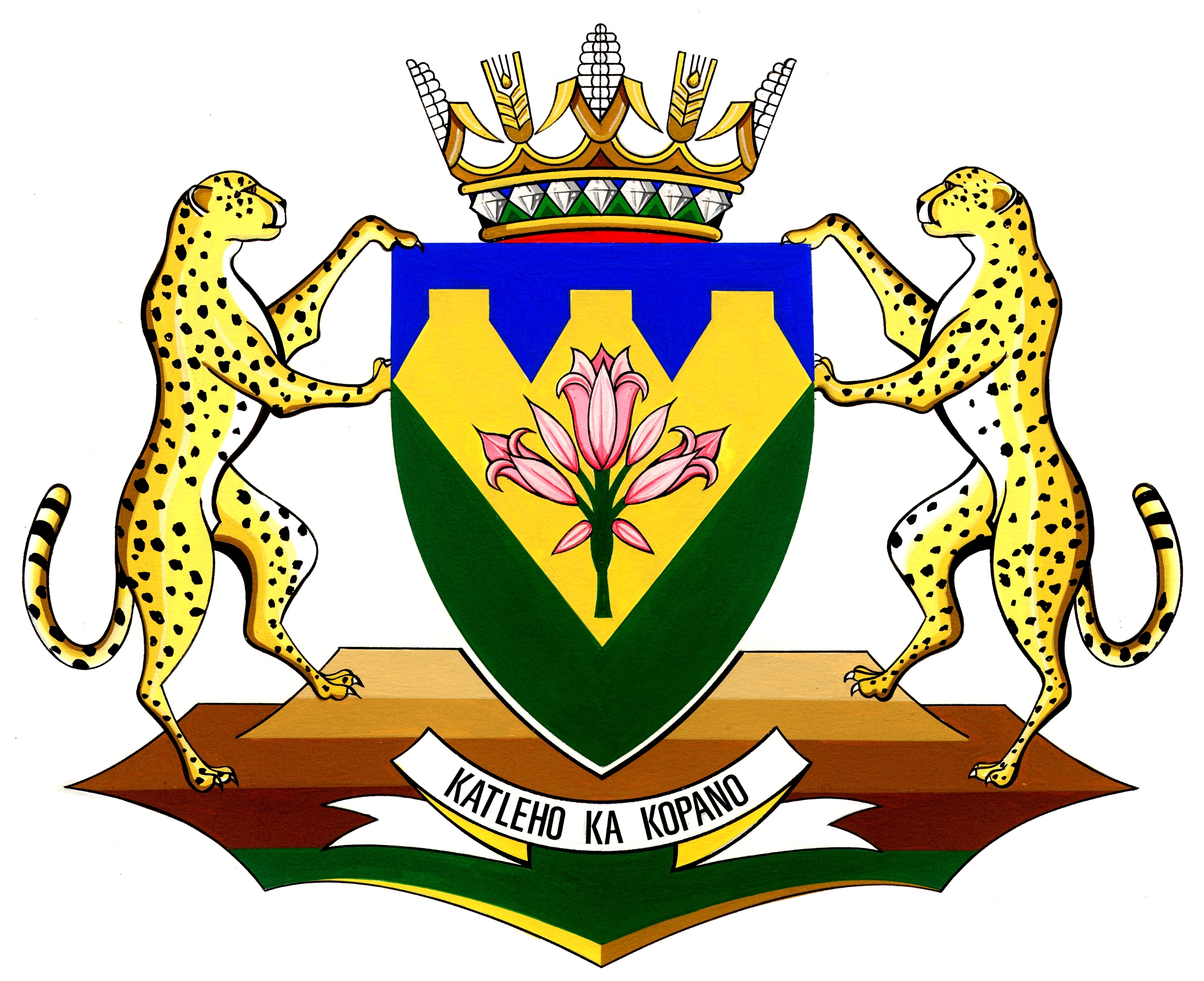
Free State Province
Coat of Arms
|
Arms of the Free State
The Free State province is located in central South Africa. It was established on 27 April 1994 and includes the former "Orange" Free State province, the homeland of Qwaqwa and the Thaba ‘Nchu area of the former Bophuthatswana. Its capital is Bloemfontein, also the judicial capital of South Africa.
The provincial arms were registered with the South African Bureau of Heraldry on 07 May 1999 and are described as follows:
- ARMS: Per chevron inverted, Or and Vert, the head of an Orange River Lily (Crinum bulbispermum) with three blossoms and four buds slipped proper and a chief dancetty, the peaks terminating in merlons, Azure; the shield ensigned of a circlet Or, embellished with representations of cut diamonds Argent, enamelled Azure against the upper and Vert against the lower facets, heightened of four heads of maize Argent, leaved Or, alternating with as many ears of wheat of the last.
- SUPPORTERS: Two cheetahs proper.
- SPECIAL COMPARTMENT: A representation of the Free State plains proper.
- MOTTO: "KATLEHO KA KOPANO" (Success through Unity).
|
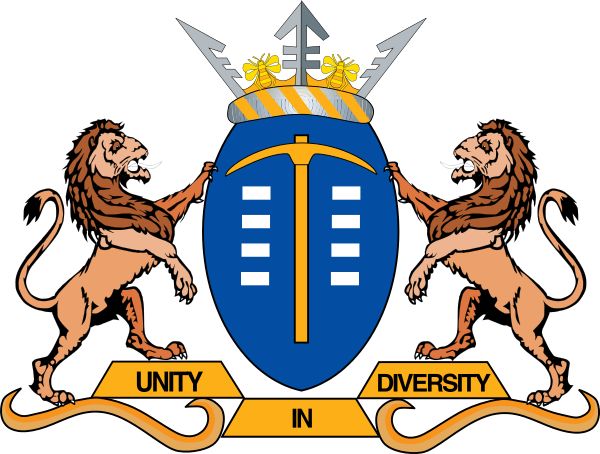
Gauteng Province
Coat of Arms
|
Arms of Gauteng
Gauteng (Sotho for "Place of Gold") province was established on 27 April 1994. It was previous part of the former Transvaal province and was initially called Pretoria-Witwatersrand-Vereeniging (PWV) until December 1994 when it was renamed Gauteng. It is the smallest province in terms of area but it nevertheless highly urbanized containing the country’s largest city, Johannesburg and administrative capital (Pretoria). Johannesburg is the provincial capital.
The provincial arms were registered with the South African Bureau of Heraldry on 20 March 1996 and are described as follows:
- ARMS: Azure, a pick erect Or, accompanied on either side by four shield thongs in pale Argent; the shield ensigned of a coronet comprising a wreathed head ring alternately Argent and Or, heightened of four chemical symbols for iron Argent, alternating with as many honey-bees volant Or.
- SUPPORTERS: Two lions proper.
- SPECIAL COMPARTMENT AND MOTTO: Upon three gold staves fesswise, conjoined 2 and 1, supported by two ornamental brackets Or, the motto UNITY IN DIVERSITY.
|
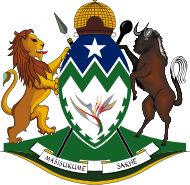
KwaZulu-Natal Province
Coat of Arms
|
Arms of KwaZulu-Natal
KwaZulu-Natal is located on the eastern seaboard of South Africa. It was established on 27 April 1994 and includes the former province of Natal and the former homeland of KwaZulu. Its capital is located in Pietermaritzburg.
The KwaZulu-Natal arms were registered at the Bureau of Heraldry on 03 December 2004 with the following blazon:
- ARMS: Argent, a fess dancetty Vert, in base, within a bordure dovetailed of the last a Strelitizia flower proper; on a chief dancetty Azure, filled of the first, a mullet Argent. The shield is ensigned of a heading Or, ther upon a Zulu hut proper. Behind the shield a spear and knobkerrie in saltire, proper.
- SUPPORTERS: On a compartment Vert, the lower edge Or, dexter a lion and sinister a black wildebeest proper.
- MOTTO: "MASISUKUME SAKHE" (Let us Stand Up and Build).
|
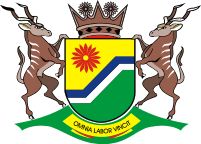
Mpumalanga Province
Coat of Arms
|
Arms of Mpumalanga
Mpumalanga (Where the sun rises) is located in north-east South Africa. It was established on 27 April 1994 and comprises the eastern part of the former Transvaal together with the former homelands of KwaNdebele and KwaNgwane and parts of Bophuthatswana and Lebowa homelands. The provincial capital is located in Mbombela (formerly Nelspruit).
The Mpumalanga arms were registered with the South African Bureau of Heraldry on 28 March 1996 with the following description:
- ARMS: Per bend sinister, inclined in the flanks per fess, Or and Vert, surmounting the partition a bend sinister per bend sinister, all similarly inclined, Azure and Argent, in dexter chief a Barberton daisy Gules, seeded Or; the shield ensigned of a coronet comprising a circlet Or jewelled of lozenges Sable and heightened of four rays alternating with as many Barberton daisies, Or.
- SUPPORTERS: Two kudu proper.
- MOTTO: "OMNIA LABOR VINCIT" (Work conquers all).
|
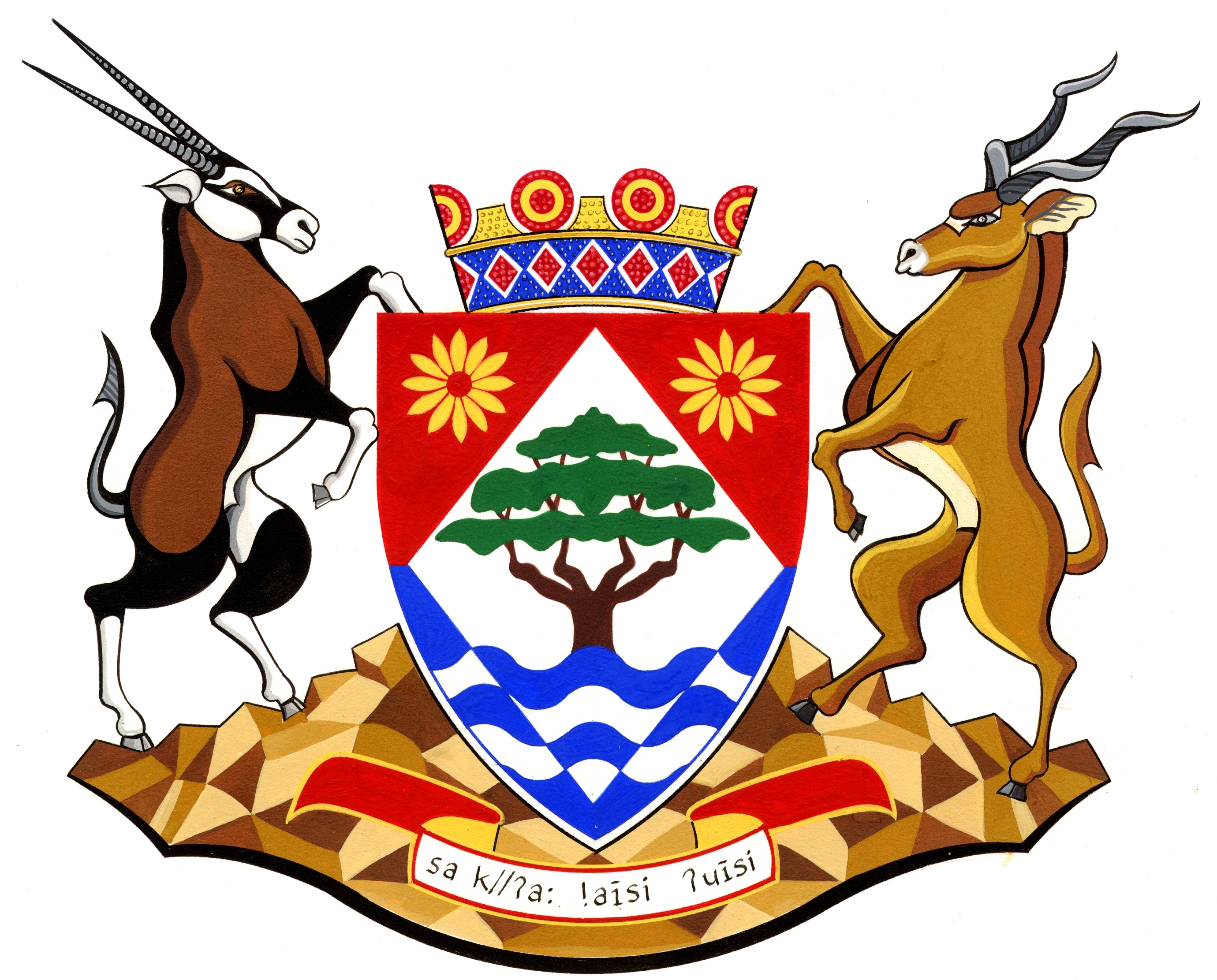
Northern Cape Province
Coat of Arms
|
Arms of the Northern Cape
The Northern Cape is located in north-west South Africa and was formerly part of the Cape Province. It was established on 27 April 1994 and its capital is located in Kimberley. It is the largest province by area with the lowest population.
The arms of the Northern Cape were registered with the South African Bureau of Heraldry on 21 January 1998 with the following blazon:
- ARMS: Per fess Gules and Azure, a lozenge Argent charged with a thorn tree proper, in base two barrulets wavy counter changed and in chief two daisies Or; the shield ensigned of a coronet comprising a circlet Or, embellished of Azure and lozengy Gules San beadwork, fimbriated Argent, heightened of six beadwork torteaux, each charged with an annulet of beadwork Or, there between as many merlons embowed of beadwork, also Or.
- SUPPORTERS: Dexter an oryx (Gazella dorcas) and sinister a kudu (Tragelaphus strepsiceros).
- SPECIAL COMPARTMENT: A rocky ground.
- MOTTO: "Sa //a !aisi 'uisi" (We go good life) in Auni, a San language from the Kalahari Gemsbok Park region of Gordonia.
|
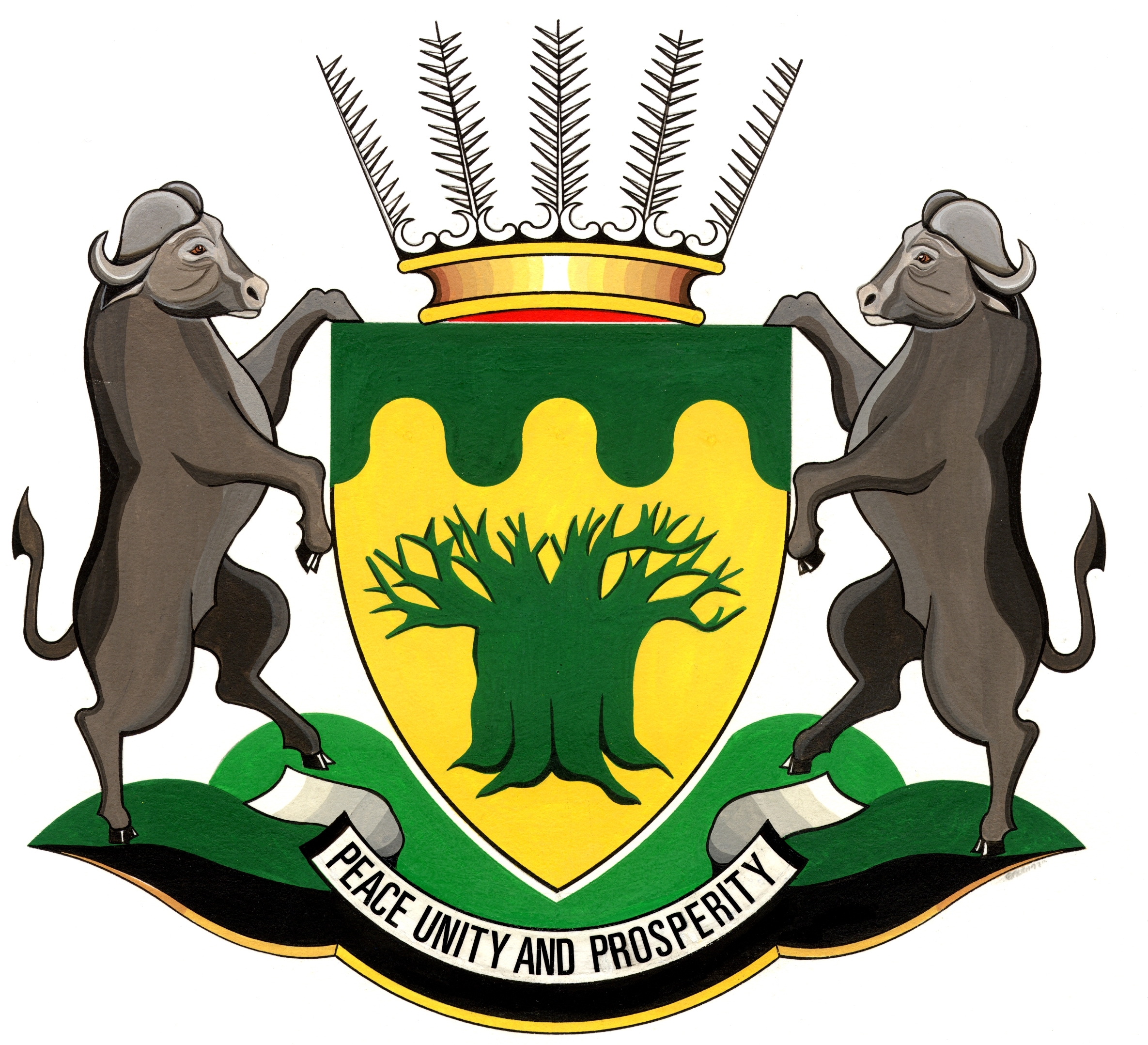
Limpopo Province
Coat of Arms
|
Arms of Limpopo Province
Limpopo Province is the northern most province of South Africa which was established on 27 April 1994 and includes parts of the former Transvaal and former Lebowa homeland and all of the former homelands of Venda and Gazankulu. Its capital is located in Polokowane (formerly Pietersburg).
The Limpopo provincial arms were registered with the South African Bureau of Heraldry on 23 March 1998 with the following description:
- ARMS: Or, a baobab tree and a chief wavy, Vert; the shield ensigned of a circlet Or, heightened of eight cycad leaves supported by sets of buffalo horns, Argent.
- SUPPORTERS: Two buffalos proper.
- SPECIAL COMPARTMENT: An undulating compartment, Vert above and Sable below, the lower edge Or.
- MOTTO: "PEACE, UNITY AND PROSPERITY".
|
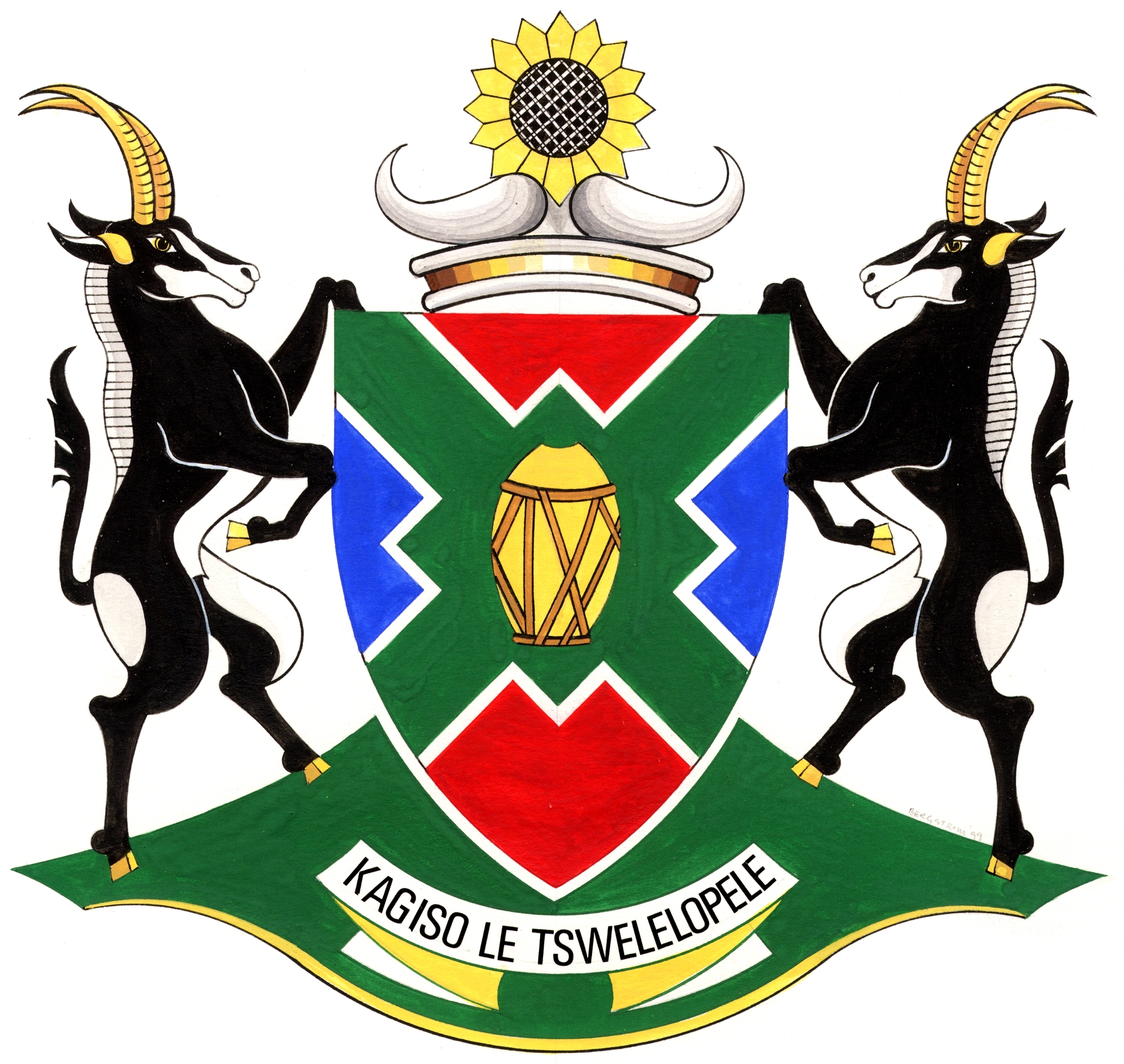
North West Province
Coat of Arms
|
Arms of the North West Province
The North West Province was established on 27 April 1994 and comprises the western portion of the former Transvaal, the north eastern part of the former Cape Province and parts of the former Bophuthatswana homeland. Its capital is located in Mafikeng (formerly Mafeking).
The arms of the North West Province were registered with the South African Bureau of Heraldry on 07 May 1999 with the following blazon:
- ARMS: Per saltire Gules and Azure, a saltire quadrate Vert, fimbriated Argent, charged in the centre with a representation of a calabash water container within a leather thong cradle, Or; the shield ensigned of a circlet edged Argent, the centre Or, resting thereupon a pair of horns Argent supporting a sunflower proper.
- SUPPORTERS: Two sable antelopes proper, horned and unguled Or.
- MOTTO: "KAGISO LE TSWELELOPELE" (Peace and prosperity).
|
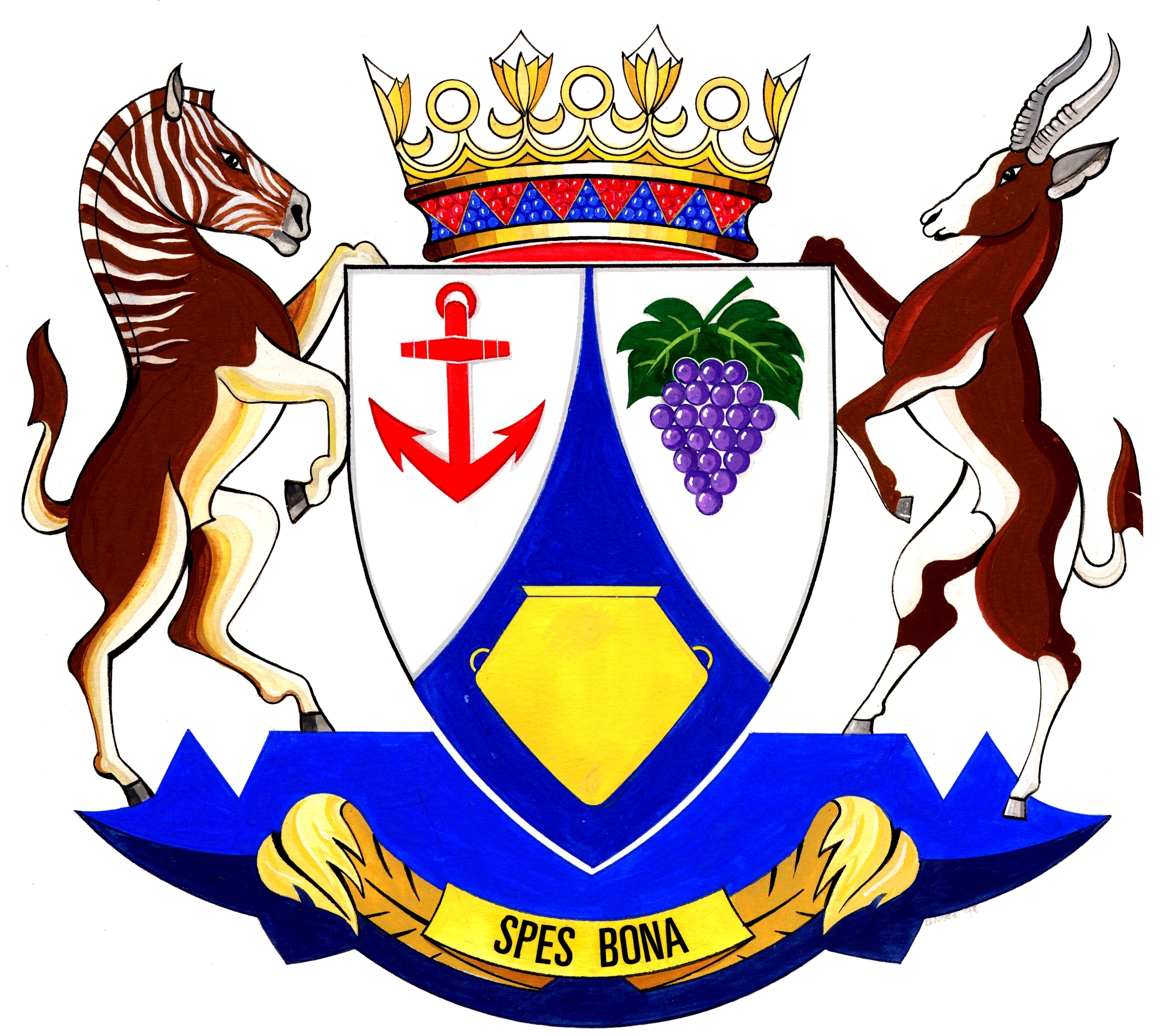
Western Cape Province
Coat of Arms
|
Arms of the Western Cape
The Western Cape is located in south-west South Africa and was part of the former Cape Province. It was established on 27 April 1994. Its capital is in Cape Town, which is also the legislative capital of South Africa.
The arms of the Western Cape were registered with the South African Bureau of Heraldry on 04 December 1998 with the following description:
- ARMS: Argent, on a pile embowed inverted throughout Azure, a Khoi clay pot with a conical base and two horizontally pierced lugs, Or, between in chief dexter an anchor Gules and sinister a bunch of grapes slipped and leaved proper; the shield ensigned of a coronet comprising a circlet Or, embellished of beadwork indented Gules and Azure heightened of six protea flowers Or, seeded Argent alternating with as many annulets, Or.
- SUPPORTERS: Dexter a quagga (Equus quagga quagga) and sinister a bontebok (Damasileus dorcas dorcas) proper.
- SPECIAL COMPARTEMENT: A stylized representation of Table Mountain Azure, bearing a riband with the fold-backs in the form of two ostrich feathers, Or.
- MOTTO: "SPES BONA" (Good Hope).
|